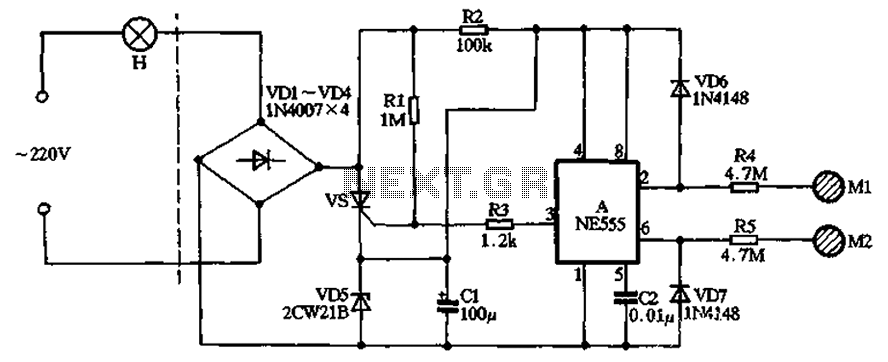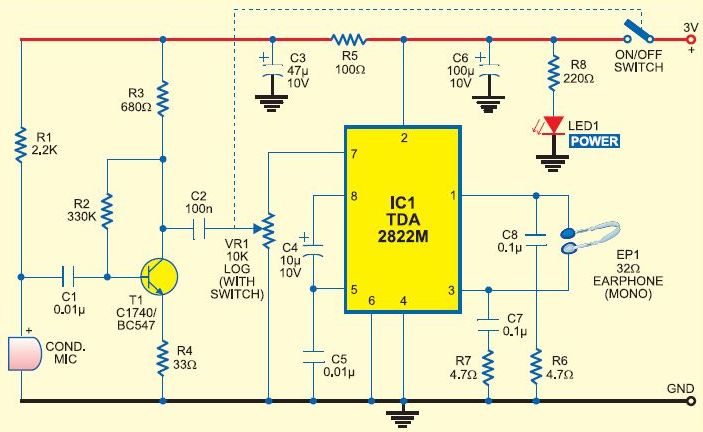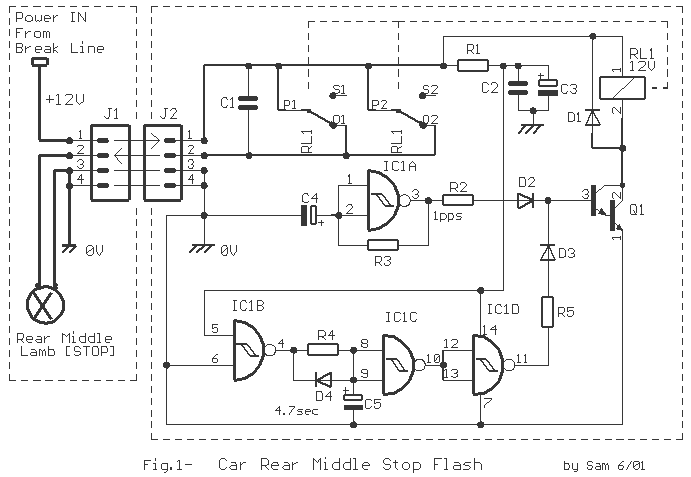
Light sensor switch circuit

This light sensor switch circuit enables the automatic activation of a lamp when ambient light levels are low, such as during nighttime. The circuit keeps the lamp illuminated for a predetermined duration. When transistors T4 and T5 are activated, the relay's LED lights up, powering the lamp. If either of the transistors becomes inactive, the lamp will turn off. The phototransistor T3 will inhibit T5 when light is detected on T3. The base-emitter junction of T2 is connected in parallel with T3, keeping T2 inactive as long as there is light. T2 will continuously reset IC1, keeping its counter outputs at a low state. As night falls, resistor R7 supplies base current to T2, allowing it to conduct. This enables the counter to begin counting impulses from the internal oscillator, keeping the lamp lit during this time. After a specified duration, when the output of Q13 transitions to a high state, T4 becomes inactive, turning off the relay's LED and the lamp. The circuit does not require an external power supply, as it is powered directly from the 220V mains. Diodes D1 to D5 rectify the voltage, and capacitor C4 filters it.
This light sensor switch circuit is designed for efficient operation in environments where automatic lighting control is desired. The circuit leverages a phototransistor (T3) to detect ambient light levels. When light is present, T3 conducts, which in turn keeps T5 off, preventing the lamp from being activated. The base-emitter junction of transistor T2 is strategically placed in parallel with T3, ensuring that T2 remains off during daylight conditions. As darkness sets in, resistor R7 provides the necessary base current to T2, allowing it to turn on.
Once T2 is activated, it initiates the counting process within the integrated circuit IC1, which is likely a timer or counter IC. The internal oscillator of IC1 generates clock pulses that are counted, and during this time, the lamp remains illuminated. The duration for which the lamp stays on is determined by the timing configuration of the circuit, which may involve additional components not explicitly detailed in the description, such as resistors and capacitors connected to the IC.
After the predetermined time has elapsed, the output of Q13 transitions to a high state, which subsequently turns off T4. This action deactivates the relay, causing the relay's LED to extinguish and the lamp to turn off, effectively completing the cycle. The entire circuit is designed to operate directly from the 220V AC mains supply, making it convenient for residential or commercial lighting applications. The diodes (D1 to D5) play a crucial role in converting the AC voltage to a usable DC voltage for the circuit, while capacitor C4 smooths out any voltage fluctuations, ensuring stable operation of the circuit components. This design emphasizes energy efficiency and automation, making it suitable for various lighting control scenarios.This light sensor switch circuit allows the automatic connection of a lamp when the light is low (at nightfall) and will maintain the lamp ON for a certain period of time. From the moment that T4 and T5 are opened, relay`s LED start to light and powers the lamp. As soon as one of the transistors is blocked the lamp will go OFF. The phototransistor T3 will be the one that blocks T5 if there is light that falls on T3. The T2 ²s base-emitter junction is connected in parallel with T3 and so will be blocked as long there is light. T2 will continuously resest IC1 whose counter outputs will be in 0 ³ state. When the night falls R7 provides base current for T2 and the transistor starts to conduct. The counter can now starts to count the impulses from the internal oscillator and in this time the light will bulb will stay lit.
After a time, when the output of Q13 goes in state 1 ³ T4 is blocked. This causes the relay`s LED to go off and the lamp too. There is no need for external power supply because the light sensor switch is powered directly from the 220V mains. D1 D5 diodes rectifies the voltage and C4 filters it. 🔗 External reference
This light sensor switch circuit is designed for efficient operation in environments where automatic lighting control is desired. The circuit leverages a phototransistor (T3) to detect ambient light levels. When light is present, T3 conducts, which in turn keeps T5 off, preventing the lamp from being activated. The base-emitter junction of transistor T2 is strategically placed in parallel with T3, ensuring that T2 remains off during daylight conditions. As darkness sets in, resistor R7 provides the necessary base current to T2, allowing it to turn on.
Once T2 is activated, it initiates the counting process within the integrated circuit IC1, which is likely a timer or counter IC. The internal oscillator of IC1 generates clock pulses that are counted, and during this time, the lamp remains illuminated. The duration for which the lamp stays on is determined by the timing configuration of the circuit, which may involve additional components not explicitly detailed in the description, such as resistors and capacitors connected to the IC.
After the predetermined time has elapsed, the output of Q13 transitions to a high state, which subsequently turns off T4. This action deactivates the relay, causing the relay's LED to extinguish and the lamp to turn off, effectively completing the cycle. The entire circuit is designed to operate directly from the 220V AC mains supply, making it convenient for residential or commercial lighting applications. The diodes (D1 to D5) play a crucial role in converting the AC voltage to a usable DC voltage for the circuit, while capacitor C4 smooths out any voltage fluctuations, ensuring stable operation of the circuit components. This design emphasizes energy efficiency and automation, making it suitable for various lighting control scenarios.This light sensor switch circuit allows the automatic connection of a lamp when the light is low (at nightfall) and will maintain the lamp ON for a certain period of time. From the moment that T4 and T5 are opened, relay`s LED start to light and powers the lamp. As soon as one of the transistors is blocked the lamp will go OFF. The phototransistor T3 will be the one that blocks T5 if there is light that falls on T3. The T2 ²s base-emitter junction is connected in parallel with T3 and so will be blocked as long there is light. T2 will continuously resest IC1 whose counter outputs will be in 0 ³ state. When the night falls R7 provides base current for T2 and the transistor starts to conduct. The counter can now starts to count the impulses from the internal oscillator and in this time the light will bulb will stay lit.
After a time, when the output of Q13 goes in state 1 ³ T4 is blocked. This causes the relay`s LED to go off and the lamp too. There is no need for external power supply because the light sensor switch is powered directly from the 220V mains. D1 D5 diodes rectifies the voltage and C4 filters it. 🔗 External reference





